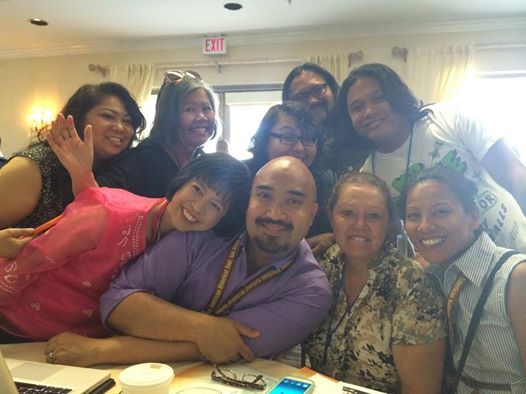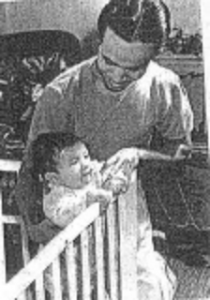Fil-Am history confab finds living link to a manong’s disrupted life
(First of two parts)
[The Filipino American National Historical Society’a (FANHS) national conference in San Diego, California on July 31 to August 3 brought together testimonies of the largest Asian immigrant population in the US about collective its achievements and history outside of its homeland. Writer Carlene Bonnivier met descendants of the early Filipino workers from Stockton. According to historian Dawn Mabalon “the first Filipino settlers arrived around 1898, and through most of the 20th century, this city was home to the largest community of Filipinos outside the Philippines.” Descendants of these early immigrants, including two sons of manongs, writer Frank Perez and farm worker Rudy Delvo, joined the conference to relive a significant era in Philippine-American relationship. We are publishing Bonnivier’s compelling accounts in two segments.]

Attendees at the Filipino American National Historical Society conference in San Diego. FACEBOOK PHOTO
SAN DIEGO, California — Before the grapes were the asparagus. Before Delano, there was Stockton. In Stockton, there was the Mariposa Hotel, the Emerald Cafe and the Rizal Social Club. Three buildings–all that’s left of the approximately six-block area known as Little Manila from 1920s up to the 1960s, when that “blighted” neighborhood was bulldozed and a freeway ran through it.
Little Manila once nourished the souls of 20,000 Filipinos (any of whom, until after World War II, would have been arrested if they’d dared to walk north of Main Street). Frank Perez, writing in the monthly Philippine Examiner in 1944, called Stockton the “Capital City of the Filipinos in the West Coast” (Little Manila is in the Heart” by Dawn Mabalon).
Of these thousands, the lives of two men were resurrected at the Filipino American National Historical Society (FANHS) Conference in San Diego. They came through in stories told to me by two sons of the manongs, so young their fathers could have been their grandfathers. Two of these oldtimers were writer Frank Perez and farm worker Cipriano “Rudy” Delvo. I met their sons, Ron and Dillon, at the conference. Their stories document the hard lives of the “manongs,” complicated by discriminatory laws, such as the anti-miscegenation (in effect prohibiting Filipinos from marrying Caucasians) at that time.
I had just finished my FANHS presentation on the anthology, Filipinotown: Voices of Los Angeles, when I saw a woman rushing toward me with a man and another, older, woman making their way behind her. The woman in the lead was Dawn Mabalon, the granddaughter of Pablo Mabalon, who owned and operated the Lafayette Lunch Counter in Little Manila from 1931 to 1983. (The day before, I had attended a panel she was part of on Historical Preservation in Filipino American Communities.) Dawn took my hand and joined it to the woman’s who was now at her side: “This is Leatrice Perez. Her husband’s photo is in your book.”
“Where?” I asked, quickly noting the open copy of the anthology that the young man was holding open on the table just next to us.
“Here,” she said. This is my husband.” Frank Perez had been photographed as he gently attended to a toddler in a crib. The picture was part of Carlos Bulosan’s article, “Filipinos Deserve a Break,” first published in PIC magazine on March 3, 1942 and reprinted in the anthology. I hadn’t read the caption in a long time, so I looked again. Curious and excited, I read: “Frank R. Perez, who came to this country in 1932 after editing a magazine in the Philippines, hopes his young son will have opportunities offered other Americans” (Filipinotown: Voices from Los Angeles).
Quickly I looked back, confused by the youthful looking man standing with Leatrice. Leatrice saw the question on my face. “This is Ron,” she said, “Frank’s son from his second marriage…to me. The boy in the photo, Ron’s half-brother Randy, was from Frank’s first marriage.” Frank was 28 in that photo and Randy was about a year old. Then Leatrice and Ron told me the story:
Frank Perez had lived in Los Angeles, working as a journalist, when he met and married his first wife, a young attractive white woman who had her sights set for stardom. I don’t know how they got around the anti-miscegenation laws, but they did. From what Frank told Leatrice later, they’d had an apparently happy marriage.
Then, one day, Frank came home to an empty house and a shocking letter. His wife wrote the letter in pencil. She said she was leaving for Mexico to become a movie star and she was taking their children with her. The devastating note did not indicate where in Mexico she might be contacted. Frank tried desperately to find them, but couldn’t. He saved the letter all of his life.
In 1943 Frank left Los Angeles and moved to Stockton where he continued as a journalist, met Leatrice, married, and started a second family. For decades, their children didn’t know about their father’s first marriage.
Randy, Frank Perez‘ son from the first marriage, was 54 when he learned about the truth surrounding his father. He had always thought that his father had abandoned him and his sister. Unbeknownst to him, Frank’s non-Filipino wife had left his father to seek a better life outside of the Stockton.
“Frank Perez was 82 when the phone call finally came,” said his wife Leatrice. It was his son, Randy. He found Frank through a diligent computer search. Randy brought his two-year-old granddaughter (Frank’s great-granddaughter) with him when they all met on Palm Sunday weekend in 1995.
Leatrice described the meeting to TheFilamLA: “When the day came and the somewhat awkward introductions were made, Randy asked his father why he had abandoned them.”
Frank left the room for only a few minutes and returned with a faded, penciled, letter in his hand, the one he’d found that awful day his family left him in Los Angeles. Randy took the note into his hands, not knowing what it could be and read it carefully. It was evident that his mother had never told him that it was her decision to leave and to leave without a trace. Stunned, Randy looked up from the letter and saw the haunted look in his father’s eyes, the yearning, the sadness, and he knew, even if he’d never read his mother’s letter, that this man could never have abandoned him.
Leatrice told TheFilAmLA that Randy remembered when he and his father hugged,” I felt like I didn’t want to let go.” Later that weekend our three sons, Gary (42), Ron (38) and Dean (37) all came to meet their half-brother, Randy and family and the other siblings from the first marriage, Susan, 53, and James, 51.
Leatrice and Ron were leaving San Diego on Sunday (from the FANHS conference), driving up the coast to Simi Valley to visit Randy at his home where he is recuperating from surgery. They were taking a copy of the anthology (Filipinotown: Voices from Los Angeles) with them to give to Randy.
On Tuesday, Leatrice called this writer and left a message: “We gave the anthology to Randy. It was the first time he’d seen the photo of himself with his father. It was very emotional for everyone. I’m just calling to say thank you.”
Perhaps the circle had closed; perhaps the heart was healed.
(Next installment: Rudy Delvo and the labor movement; meeting Larry Itliong and Philip Vera Cruz).
RELATED STORIES
Two important Fil-Am confabs get major sponsor
Historical society pans ‘Cesar Chavez’ film for inaccuracies
